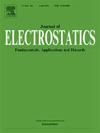Inactivation effect and mechanism of Microcystis aeruginosa by in-liquid pulsed discharge plasma
IF 2.1
4区 工程技术
Q3 ENGINEERING, ELECTRICAL & ELECTRONIC
引用次数: 0
Abstract
The harmful algal bloom outbreaks damage river and lake ecosystems and impact the environments of water bodies. Microcystis aeruginosa (M. aeruginosa) is the predominant algal species in cyanobacteria blooms, releasing toxins into the water column during its growth and decay. The rapid degradation of toxins and efficient inactivation of M. aeruginosa is a technical challenge. This study explores the use of in-liquid pulsed discharge plasma (LPDP) for the inactivation of M. aeruginosa. The investigation includes changes in the inactivation ratio, Chlorophyll-a (Chl-a) concentration, and the underlying inactivation mechanisms under various discharge conditions. This study achieved 100 % inactivation by plasma treatment for 20 min at a peak voltage of 30 kV and an electrode spacing of 7 mm, and the concentration of Chl-a was reduced from 1.08 mg/L to 0.14 mg/L (on the fourth day of re-culturing). The collaboration of ultraviolet light, strong electric fields, and reactive species (·O, H2O2, and O3) generated during the discharge process induces apoptosis, reduces enzyme activity, and facilitates the removal of microcystins to realize green and efficient algal removal.

液体脉冲放电等离子体对铜绿微囊藻的灭活作用及机制
有害藻华的爆发破坏河湖生态系统,影响水体环境。铜绿微囊藻(M. aeruginosa)是蓝藻华中的主要藻类,在其生长和腐烂过程中释放毒素到水柱中。毒素的快速降解和铜绿假单胞菌的有效灭活是一项技术挑战。本研究探讨了液体脉冲放电等离子体(LPDP)对铜绿假单胞菌灭活的作用。研究了不同放水条件下叶绿素-a (Chl-a)浓度和失活率的变化及其失活机制。在峰值电压为30 kV,电极间距为7 mm的条件下,等离子体处理20 min,达到100%失活,Chl-a浓度从1.08 mg/L降至0.14 mg/L(再培养第4天)。通过紫外光、强电场和放电过程中产生的活性物质(·O、H2O2、O3)协同作用,诱导细胞凋亡,降低酶活性,促进微囊藻毒素的去除,实现绿色高效除藻。
本文章由计算机程序翻译,如有差异,请以英文原文为准。
求助全文
约1分钟内获得全文
求助全文
来源期刊

Journal of Electrostatics
工程技术-工程:电子与电气
CiteScore
4.00
自引率
11.10%
发文量
81
审稿时长
49 days
期刊介绍:
The Journal of Electrostatics is the leading forum for publishing research findings that advance knowledge in the field of electrostatics. We invite submissions in the following areas:
Electrostatic charge separation processes.
Electrostatic manipulation of particles, droplets, and biological cells.
Electrostatically driven or controlled fluid flow.
Electrostatics in the gas phase.
 求助内容:
求助内容: 应助结果提醒方式:
应助结果提醒方式:


